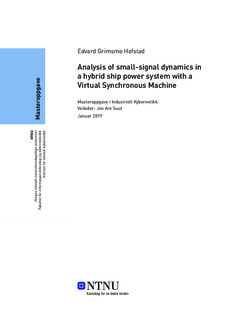| dc.contributor.advisor | Suul, Jon Are Wold | |
| dc.contributor.author | Hofstad, Edvard Grimsmo | |
| dc.date.accessioned | 2019-10-31T15:05:20Z | |
| dc.date.issued | 2019 | |
| dc.identifier | no.ntnu:inspera:35771502:38200615 | |
| dc.identifier.uri | http://hdl.handle.net/11250/2625680 | |
| dc.description.abstract | Et økende fokus på miljøpåvirkningen fra marine kraftsystemer som benytter seg av fossilt brensel har resultert i implementeringen av Utlippskontrollerte soner og et økende krav til nivåer av utslipp av forurensede gasser fra marine kraftinstallasjoner. En løsning for å imøtekomme disse kravene og redusere det totale forbruket av fossilt brensel for energiproduksjon er implementeringen av Energy Storage systems. Et eksempel på dette er et batterisystem. Hvis dette benyttes i et kraftsystem med AC-distribusjon er det mest vanlige grensesnittet for trefase transformasjon en trefase spenningskilde-konverter.
Denne oppgaven undersøker en VSM implementasjon i et marint kraftsysem. Designet på VSMen er utført slik at frekvensen til den virtuelle rotoren blir produsert internt. Dette gjør at behovet for en PLL forsvinner. Dette gir rom for muligheten til at VSMen kan operere kraftsystemet alene, uten et behov for at andre komponenter skal styre frekvensen uten å bytte styresystem for VSMen. Kraftsystemet undersøkt er et tradisjonelt marint kraftsystem system bestående av en SM, en VSM og en lastmodell. En ulineær tilstandsrommodell har blitt laget for hver komponent. Disse har blitt linearisert til småsignalmodeller. Modellene består av VSM koblet til et nett, SM koblet til nett, VSM og SM koblet sammen og VSM, SM og lastmodell koblet sammen.
Småsignal modellene utarbeidet har gjort det mulig å bruke lineære analyseverktøy for å analysere systemets stabilitet og system responsen. Småsignalmodellene ble validert ved å sammenligne responsen ved en forstyrrelse med tilsvarende modeller laget I Simulink. Dette ga muligheten for å validere modellene og vurdere responsen til systemet ved en forstyrrelse. En eigenverdianalyse ble utført på småsignalmodellene for å undersøke kritiske moder og vurdere stabilitetsmarginen.
Analysen viser at systemet er stabilt og har en god dynamisk respons for transienter. Eigenverdianalysen viser at systemet har en god stabilitetsmargin. Systemet fungerer for alle komponenter tilkoblet og VSMen viser evnen til å tilpasse seg nettet den er koblet til. VSMen er i stand til å fungere for alle systemene introdusert uten å måtte endres. Dette viser muligheten for at en inverter kan operere et nett uten behov for en endring i kontrollsystemet. | |
| dc.description.abstract | An increasing focus on the environmental impacts from marine power systems utilizing fossil fuel have resulted in implementation of Emission Controlled Areas, and an increasing demand for levels of pollution forces changes in the marine power systems. A solution for accommodating these demands and lowering the total use of fossil fuel for energy production is the implementation of energy storage systems. An implementation of such a system is a battery energy system. If this is used in a ship power system with AC-distribution the most common interface is for three phase transformation is three-phase voltage source converters.
This thesis studies a VSM implementation in a marine power grid. The design of the VSM is done such that the frequency of the virtual rotor is produced internally, removing the need for a Phase Locked Loop. This also gives room for the possibility of islanded operation of the power grid with only the VSM connected, using the same control topology for the VSM. The power grid studied is designed as a traditional marine power grid with a SM, a VSM connected to a battery energy system and a load model. A nonlinear state space model of these components has been developed and small signal models have been made for each. Small signal models have been made for the VSM with grid connection and connected to the load model, SM with grid connection and connected to the load model and a full model containing all three components. This has given the possibility to study the dynamics of the system and gain insight in the stability.
The small signal model developed have given the possibility to use linear analysis tools to evaluate stability and system response. The validation process gave room for validating the correctness of the small signal models and opened the possibility for assessing the system response of the disturbance. An eigenvalue analysis of the different small signal models has been done to determine critical modes and which states is influenced by these. This analysis has given further insight in the system response and the way that it is coupled. The eigenvalue analysis has also been tested for operational area of the power grid giving insight in how the system dynamics of the base case studied change as the total power flow is altered.
The analysis shows that the system is stable and have a good dynamic response for transients. The eigenvalue analysis shows that the system has a good stability margin, meaning that the system is not in danger of becoming unstable. The system is able to function with all components (SM, VSM,load) connected. The VSM have shown the ability to adapt to the frequency in the grid by synchronizing to the other frequency setting component in the grid. This shows the possibility of a grid being operated by an inverter without the need for a change in control system. | |
| dc.language | eng | |
| dc.publisher | NTNU | |
| dc.title | Analysis of small-signal dynamics in a hybrid ship power system with a Virtual Synchronous Machine | |
| dc.type | Master thesis | |
